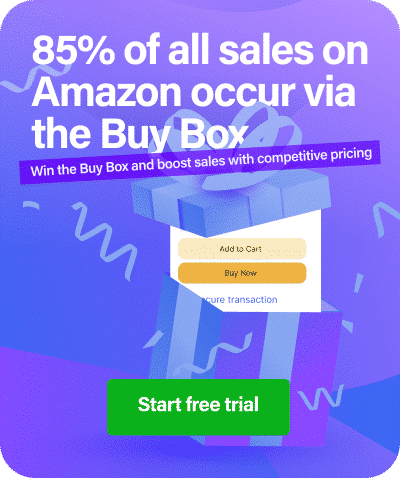It is indisputable that Amazon takes the eCommerce crown, with the site offering a range of over twelve million products. It’s one of the first places a consumer will go, whether they are in need of some home decor, pet food, or skincare, meaning the opportunities available to third-party sellers are quite frankly endless.
Why? It all comes down to trust and the impenetrable reputation that Amazon has established all over the world as a hub to find all kinds of quality products at low prices.
Although the endless range of products available is how Amazon has managed to become a top eCommerce player worldwide, the sheer volume of opportunities can be daunting for those looking to start selling. The key to becoming a successful third-party seller and generating revenue from other people’s products is to have an extensive market research strategy in place.
In a nutshell, you need to understand what sells, why it sells, and how people are searching for it online. Third-party selling is all about profiting from products that are already popular and in demand without setting yourself up to fail by selling a product in an already saturated market.
So, how can you go about finding profitable products to sell on Amazon and start capitalising on these? Repricer.com has put together a simple guide that considers product keywords, profit margins, product demand, and competitor research. Follow this and you’re sure to pinpoint a range of profitable products to kickstart an effective Amazon selling strategy.
Is Selling on Amazon Worth it?
First things first, if you’re still unsure about whether to become an Amazon seller and start widening your eCommerce product ranges, face the facts. In 2022, Amazon has generated revenue of more than $513 billion and more than 50% of these sales come from third-party sellers.
You don’t want to miss out on the opportunity Amazon provides, allowing those looking to enter the world of ecommerce the chance to benefit from the incredible level of trust already established between the business and consumers.
Whether you are new to online retail or you have an established brand and are looking for profitable products to sell on Amazon that will widen your offering, its essential that your product research is entirely data-driven. Fail to delve deep enough into your market research or consider a product’s long-term value (LTV) and you can end up with a huge volume of stock that has become outdated or fruitless.
Finding Profitable Products to Sell on Amazon
To kickstart your initial research, there are several key factors to consider and tools to use to your advantage.
1. Amazon Best Sellers
Amazon itself offers tons of consumer-based data up on a plate for sellers to use to educate their decisions around what to sell on Amazon. Spend time analysing the Best Sellers area to see a comprehensive list of products rated from 1-100. Best Sellers lists are entirely based on the volume of sales, so you can see what people are buying the most either from general categories or more specific sub-categories and niches.
You can go even further with your onsite research using Amazon’s own Best Sellers Rank (BSR) metric. Each product is assigned a value based on the volume of products in a certain category to show sellers where it ranks in terms of sales. While you can’t use BSR as a direct indicator of a product’s sales potential, it’s a valuable starting point to generate a rough guide on how many sales you are likely to make a day and decide whether it’s a worthwhile contender to introduce into your own eCommerce product range.
Do not forget to consider the size of each subcategory. BSR provides useful data to work with but each ranking is only relative to the category it appears in and rankings cannot be compared across categories. Calculate the percentage a product ranks in by searching ‘[]’ for a specific category in the Amazon search bar to find the total number of products in that niche.
Aiming to pinpoint products that rank in the top 10% of a category comprised of a large volume of products, for example, is far more valuable than trying to compare rankings across categories, with each category having its own patterns in demand and variety of factors at play.
To identify BSR quickly and easily without having to click through to each product, install the DS Amazon Quick View Google Chrome extension. You can peruse a products’ various rankings in different categories as well as their pricing history without having to spend time navigating between product pages.
2. Keyword Research

After you’ve effectively utilised Amazon’s own consumer-based data sets and tools, it’s important to do follow this up with thorough keyword research, taking into account search volumes for both Google and Amazon itself.
There are a huge range of product keyword research tools out there that you should consider investing in to find profitable products if you want to implement a long-term and agile eCommerce strategy.
- Jungle Scout
Jungle Scout sells itself as an ‘all-in-one platform for selling on Amazon’, and rightly so. Their ‘opportunity finder’ is hugely valuable for gaining a deep and solid understanding of search volumes for specific products, the level of competition in varying niches and emerging sales opportunities. You can even install their Google Chrome extension to browse products, analyse their search volume and the nature of the competition as you go.
- Ahrefs
Another favourite for tackling keyword research is Ahrefs, used by SEO professionals and agencies worldwide to find relevant keyword targeting opportunities and inspect competitor domains. To use Ahrefs to carry out invaluable product keyword research you can customise your keyword searches to evaluate shopping results and, in an ideal world, find keyword opportunities with relatively low competition but high demand.
- Amazon
Believe it or not, you can carry out some initial keyword research using Amazon itself. Simply type a product into the search bar to be presented with a wide range of keyword variants that consumers are commonly using to find that product – all in order of search volume.
3. Product Reviews
Once you have identified a product niche or have a range of products in mind, take a close look at reviews for some further insight. First, think about the volume of reviews. A product with thousands of existing reviews is usually the sign of an over-saturated market, whereas one with a complete lack of reviews can signal a lack of demand.
Amazon product reviews can reveal incredibly valuable information about gaps in the market too, with many consumers going into detail about the pros and cons of a certain product and outlining where it’s lacking. Make the most of this free information about the pain points of your target consumers, learn from other sellers’ mistakes and aim to offer a product that goes one step further than the competition.
Understanding Product Demand
When doing your market research on Amazon there are a whole host of considerations such as market trends, seasonal changes, profit margins that should never be neglected.
Market Trends and Seasonal Change
A completely free resource that can provide valuable insight into market trends and variations in product demand is Google Trends: simply type in a product’s key search term to be presented with a clear graph outlining the ebbs and flows in the product’s demand. You can use Google’s own data to identify clear seasonal trends and pinpoint the time of year that may be best to start selling a certain product or, alternatively, aim to find a profitable product that is in demand all year round for consistent monthly recurring revenue (MRR).
Profit Margins
As we mentioned earlier, BSR is not the be-all and end-all when it comes to determining the LTV or potential of stocking a certain product. Profit margins should be at the forefront of your mind all the time to make sure you are looking for products that will make you money.
Those new to eCommerce and third-party selling should always aim for a 50% profit margin with each product you bring into your inventory. This way, you can make sure that you are still making a profit whether you bring in a small or larger volume of initial sales.
When determining your profit margins, always consider an item’s weight, dimensions, and shelf life. Large and heavy items can be expensive to ship taking away from your profits considerably over time. On top of this, think about how soon a product is likely to expire, go out of trend or be replaced by a new or updated version. This way, you can predict any dips in demand and avoid being left with a large volume of stock and no one to buy it.
Optimize Your Amazon Profits with Repricer.com
As you can hopefully see, deciding what to sell on Amazon should be a process based on extensive and calculated research taking into account a wide range of factors. Once you’ve created an inventory of well-researched stock and are ready to start selling, it’s time to think about pricing.
To generate sales and stand out from competitors, you need a solid pricing strategy and repricing tool to support you. This is where Repricer.com comes in, giving third-party sellers the ability to optimize their product prices easily.
Check out our free 14-day trial to see how we can help you overtake your competitors and win more Buy Box Alternatively, get in touch with our team if you have any queries about our software.






